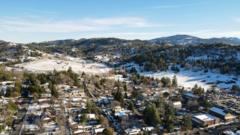As many seek clarity on impending seismic events, experts emphasize preparedness over predictions.
**The Challenge of Predicting Earthquakes: Why Accurate Forecasts Remain Elusive**

**The Challenge of Predicting Earthquakes: Why Accurate Forecasts Remain Elusive**
Despite social media claims, scientists assert earthquakes can't be accurately predicted.
In mid-October, Brent Dmitruk, a self-proclaimed earthquake predictor, declared to his followers that an earthquake would soon occur near Eureka, California. In December, a magnitude 7.3 earthquake indeed struck that very region, leading Dmitruk to gain notoriety among his online audience as people sought his insight for future seismic predictions. "People may dismiss what I do, but how can you argue it's simply coincidence? It takes skill to foresee where earthquakes will manifest," he claimed. However, experts in seismology point out a significant flaw in his assertions: predicting earthquakes remains an impossibility in the wake of scientific understanding.
Earthquakes induce a unique combination of anxiety and anticipation, particularly for those residing along the perilous west coast of North America. The specter of "the big one" looms large in the minds of millions, with notable past disasters such as the Northridge earthquake, which claimed 57 lives and injured thousands, adding to this anxiety. Lucy Jones, a renowned seismologist with over 30 years of experience at the US Geological Survey (USGS), has dedicated her research to understanding earthquake probabilities and enhancing resilience against potential calamities. According to Jones, the human tendency to seek patterns in chaotic times often leads individuals like Dmitruk to wrongly claim insight into seismic events.
Annually, the USGS records approximately 100,000 earthquakes across the globe, which contributes to the public's desire for early warnings. The Eureka area itself has experienced over 700 tremors in the past year, highlighting its status as one of the most seismically active regions in the US due to the convergence of three tectonic plates. While Dmitruk's prediction proved true, Jones argues that making educated guesses in such a seismically volatile area is akin to pointing out trends in weather; it may be accurate, but it does not derive from predictability. She emphasizes that geological factors influencing earthquakes are complex and dynamic, often leading to unpredictable outcomes.
The USGS tentatively estimates earthquake probabilities within certain timeframes, based on historical data and regional analysis. For example, the Cascadia subduction zone typically experiences significant seismic events every 300 to 500 years, while the San Andreas fault may see major earthquakes every 200 to 300 years. However, experts stress that predicting the exact timing, location, and magnitude of any earthquake remains out of reach for scientists.
Interestingly, Jones has received countless unsolicited earthquake predictions over her career, humorously noting that someone would inevitably be "lucky" with correct forecasts when someone makes predictions so frequently. Dmitruk's predictions have often shifted over time, bolstering skepticism regarding their validity. His ambitious forecasts include an extraordinarily powerful 10.3 magnitude earthquake, projected to cause widespread disruption across various regions. Yet, despite the lack of scientific backing, Dmitruk firmly rejects the idea that chance is his predictor, mirroring the human desire to interpret randomness as pattern.
Preparedness, rather than prediction, should be the focus when it comes to earthquakes, according to experts. Each October, millions of Americans participate in the Great Shake Out, a large-scale earthquake drill aimed at educating citizens on the best practices during seismic events—namely the Drop, Cover, and Hold On approach. This initiative, first developed by the Southern California Earthquake Center, has grown into an international phenomenon. Regional alert systems such as USGS's ShakeAlert offer life-saving seconds of warning by detecting pressure waves from earthquakes, allowing residents to take cover.
While predicting the precise occurrence of an earthquake may remain unattainable for scientists, increasing awareness and preparedness serves as the most responsible course of action for individuals living in high-risk areas.
Earthquakes induce a unique combination of anxiety and anticipation, particularly for those residing along the perilous west coast of North America. The specter of "the big one" looms large in the minds of millions, with notable past disasters such as the Northridge earthquake, which claimed 57 lives and injured thousands, adding to this anxiety. Lucy Jones, a renowned seismologist with over 30 years of experience at the US Geological Survey (USGS), has dedicated her research to understanding earthquake probabilities and enhancing resilience against potential calamities. According to Jones, the human tendency to seek patterns in chaotic times often leads individuals like Dmitruk to wrongly claim insight into seismic events.
Annually, the USGS records approximately 100,000 earthquakes across the globe, which contributes to the public's desire for early warnings. The Eureka area itself has experienced over 700 tremors in the past year, highlighting its status as one of the most seismically active regions in the US due to the convergence of three tectonic plates. While Dmitruk's prediction proved true, Jones argues that making educated guesses in such a seismically volatile area is akin to pointing out trends in weather; it may be accurate, but it does not derive from predictability. She emphasizes that geological factors influencing earthquakes are complex and dynamic, often leading to unpredictable outcomes.
The USGS tentatively estimates earthquake probabilities within certain timeframes, based on historical data and regional analysis. For example, the Cascadia subduction zone typically experiences significant seismic events every 300 to 500 years, while the San Andreas fault may see major earthquakes every 200 to 300 years. However, experts stress that predicting the exact timing, location, and magnitude of any earthquake remains out of reach for scientists.
Interestingly, Jones has received countless unsolicited earthquake predictions over her career, humorously noting that someone would inevitably be "lucky" with correct forecasts when someone makes predictions so frequently. Dmitruk's predictions have often shifted over time, bolstering skepticism regarding their validity. His ambitious forecasts include an extraordinarily powerful 10.3 magnitude earthquake, projected to cause widespread disruption across various regions. Yet, despite the lack of scientific backing, Dmitruk firmly rejects the idea that chance is his predictor, mirroring the human desire to interpret randomness as pattern.
Preparedness, rather than prediction, should be the focus when it comes to earthquakes, according to experts. Each October, millions of Americans participate in the Great Shake Out, a large-scale earthquake drill aimed at educating citizens on the best practices during seismic events—namely the Drop, Cover, and Hold On approach. This initiative, first developed by the Southern California Earthquake Center, has grown into an international phenomenon. Regional alert systems such as USGS's ShakeAlert offer life-saving seconds of warning by detecting pressure waves from earthquakes, allowing residents to take cover.
While predicting the precise occurrence of an earthquake may remain unattainable for scientists, increasing awareness and preparedness serves as the most responsible course of action for individuals living in high-risk areas.



















